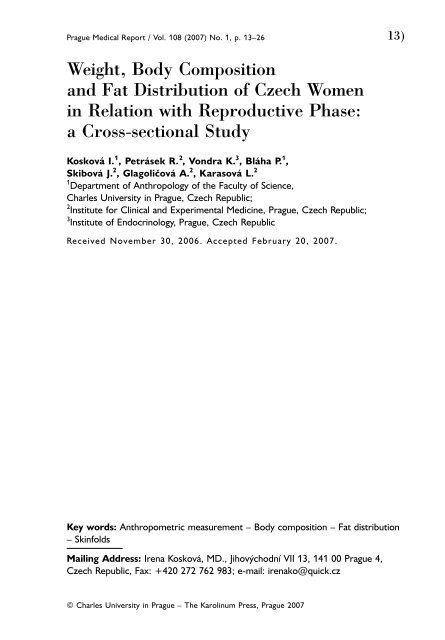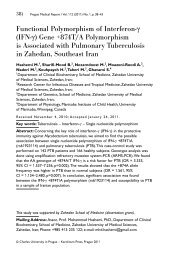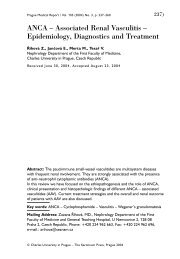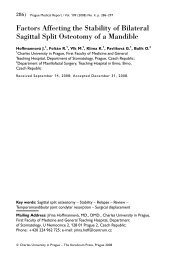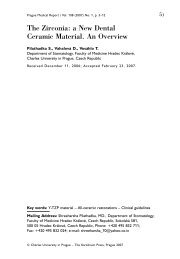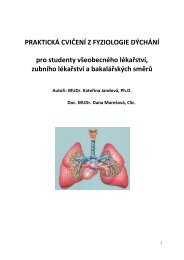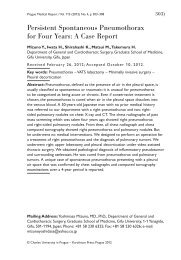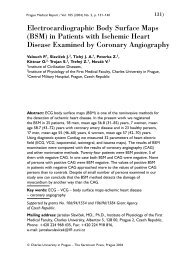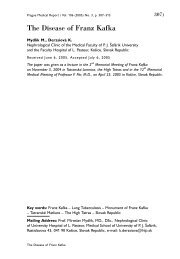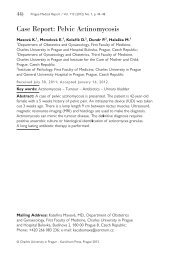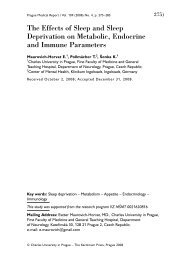Weight, Body Composition and Fat Distribution of Czech Women in ...
Weight, Body Composition and Fat Distribution of Czech Women in ...
Weight, Body Composition and Fat Distribution of Czech Women in ...
Create successful ePaper yourself
Turn your PDF publications into a flip-book with our unique Google optimized e-Paper software.
Prague Medical Report / Vol. 108 (2007) No. 1, p. 13–26<br />
13)<br />
<strong>Weight</strong>, <strong>Body</strong> <strong>Composition</strong><br />
<strong>and</strong> <strong>Fat</strong> <strong>Distribution</strong> <strong>of</strong> <strong>Czech</strong> <strong>Women</strong><br />
<strong>in</strong> Relation with Reproductive Phase:<br />
a Cross-sectional Study<br />
Kosková I. 1 , Petrásek R. 2 , Vondra K. 3 , Bláha P. 1 ,<br />
Skibová J. 2 , Glagoličová A. 2 , Karasová L. 2<br />
1 Department <strong>of</strong> Anthropology <strong>of</strong> the Faculty <strong>of</strong> Science,<br />
Charles University <strong>in</strong> Prague, <strong>Czech</strong> Republic;<br />
2 Institute for Cl<strong>in</strong>ical <strong>and</strong> Experimental Medic<strong>in</strong>e, Prague, <strong>Czech</strong> Republic;<br />
3 Institute <strong>of</strong> Endocr<strong>in</strong>ology, Prague, <strong>Czech</strong> Republic<br />
Received November 30, 2006. Accepted February 20, 2007.<br />
Key words: Anthropometric measurement – <strong>Body</strong> composition – <strong>Fat</strong> distribution<br />
– Sk<strong>in</strong>folds<br />
Mail<strong>in</strong>g Address: Irena Kosková, MD., Jihovýchodní VII 13, 141 00 Prague 4,<br />
<strong>Czech</strong> Republic, Fax: +420 272 762 983; e-mail: irenako@quick.cz<br />
<strong>Body</strong> © Charles <strong>Composition</strong> University <strong>and</strong> <strong>in</strong> <strong>Fat</strong> Prague <strong>Distribution</strong> – The Karol<strong>in</strong>um <strong>of</strong> <strong>Czech</strong> Press, <strong>Women</strong> Prague 2007
14) Prague Medical Report / Vol. 108 (2007) No. 1, p. 13–26<br />
Abstract: A sample <strong>of</strong> 213 healthy <strong>Czech</strong> women was classified <strong>in</strong>to four groups<br />
accord<strong>in</strong>g to their reproductive phase: fully reproductive, premenopausal,<br />
menopausal <strong>and</strong> postmenopausal women. Changes <strong>in</strong> body weight, body<br />
composition <strong>and</strong> fat distribution were studied <strong>in</strong> those four groups us<strong>in</strong>g the<br />
classical anthropometric method. <strong>Body</strong> weight rises till the menopause with no<br />
further <strong>in</strong>crease. A decrease <strong>in</strong> relative contribution <strong>of</strong> muscle <strong>and</strong> bone mass was<br />
observed. The progressive <strong>in</strong>crease <strong>in</strong> fat mass with age was clearly demonstrated,<br />
both the fat mass weight (r=0.38, p
Prague Medical Report / Vol. 108 (2007) No. 1, p. 13–26<br />
15)<br />
6 to 55 years [11], MONICA [12, 13] <strong>and</strong> the study <strong>of</strong> the thyroid impairment<br />
prevalence which gave also data <strong>of</strong> menopause onset <strong>and</strong> some anthropometric<br />
parameters – BMI, WHR, 4 sk<strong>in</strong>folds [13].<br />
Material <strong>and</strong> Methods<br />
Subjects were outpatients <strong>of</strong> gynaecological consultations <strong>in</strong> Prague 2, women<br />
between 20–65 years <strong>of</strong> age, with BMI below 35 who had not been treated for<br />
diabetes, cardiovascular diseases, lipid metabolism impairment, endocr<strong>in</strong>e<br />
impairments nor other serious diseases <strong>and</strong> had given consent to participate <strong>in</strong> this<br />
study. Age <strong>in</strong>tervals represent<strong>in</strong>g each reproductive phase <strong>of</strong> average central<br />
European women were established [14] <strong>and</strong> women were accepted to have about<br />
50 persons <strong>in</strong> each group. Total number was 213: women <strong>in</strong> fully reproductive<br />
phase aged 20–36 (n=58, mean age 26.89, SD 4.69), premenopausal women aged<br />
38–45 (n=48, mean age 42.54, SD 2.50), menopausal women between the ages <strong>of</strong><br />
48 <strong>and</strong> 54 (n=62, mean age 51.34, SD 2.51) <strong>and</strong> postmenopausal women aged<br />
between 55 <strong>and</strong> 65 (n=45, mean age 59.53, SD 2.71). Questionnaires <strong>and</strong> medical<br />
consultation were used to ascerta<strong>in</strong> the health status, current medication, family<br />
<strong>and</strong> personal medical history, major weight changes through life, alimentary habits,<br />
<strong>and</strong> daily physical activity. <strong>Women</strong> tak<strong>in</strong>g medication, which can modify body<br />
composition were not <strong>in</strong>cluded, however oral contraception (OC) <strong>and</strong> hormonal<br />
replacement therapy (HRT) had no <strong>in</strong>fluence on the choice <strong>of</strong> prob<strong>and</strong>s thus<br />
represent<strong>in</strong>g the real situation <strong>of</strong> healthy <strong>Czech</strong> women. We only had the<br />
<strong>in</strong>formation that the prob<strong>and</strong> was tak<strong>in</strong>g OC/HRT at the time <strong>of</strong> exam<strong>in</strong>ation; the<br />
length <strong>of</strong> the treatment was ignored. Out <strong>of</strong> 58 women <strong>in</strong> the fully reproductive<br />
period there were 37 (64%) on OC, out <strong>of</strong> 48 <strong>in</strong> the premenopausal period<br />
11 (23%), out <strong>of</strong> 62 menopausal women 21 (34%) were on HRT <strong>and</strong> out <strong>of</strong><br />
45 women <strong>in</strong> the postmenopausal period 14 (31%). Blood was taken to assess<br />
endocr<strong>in</strong>e <strong>and</strong> metabolic parameters, <strong>in</strong> women hav<strong>in</strong>g their menstrual cycle <strong>in</strong> the<br />
early follicular phase <strong>of</strong> the cycle, between day 1 <strong>and</strong> 7 s<strong>in</strong>ce the beg<strong>in</strong>n<strong>in</strong>g <strong>of</strong><br />
period. Follicle-stimulat<strong>in</strong>g (FSH), lute<strong>in</strong>iz<strong>in</strong>g hormone (LH) <strong>and</strong> estradiol as<br />
markers <strong>of</strong> reproductive phases were measured <strong>in</strong> serum samples with the RIA<br />
method (Institute <strong>of</strong> Cl<strong>in</strong>ical <strong>and</strong> Experimental Medic<strong>in</strong>e, Prague) <strong>and</strong> they<br />
represent the only laboratory values presented <strong>in</strong> this article. Other endocr<strong>in</strong>e <strong>and</strong><br />
metabolic parameters will be published <strong>in</strong> the next article (<strong>in</strong> press) <strong>in</strong>clud<strong>in</strong>g the<br />
methods <strong>of</strong> their assessment.<br />
Anthropometric measurement: weight with medical scales to the nearest 0.1 kg<br />
with subjects wear<strong>in</strong>g underwear only, heights with anthropometer <strong>in</strong> the st<strong>and</strong><strong>in</strong>g<br />
position to the nearest 0.1 cm – body height, height <strong>of</strong> suprasternal, iliocristal,<br />
iliosp<strong>in</strong>al, symphysion po<strong>in</strong>ts from floor, widths with pelvimeter <strong>and</strong> kefalometer to<br />
the nearest 0.1 cm: biacromial, transverse diameter <strong>of</strong> the chest, bicristal <strong>and</strong><br />
bisp<strong>in</strong>al width, sagittal diameter <strong>of</strong> the chest, width <strong>of</strong> the distal humeral <strong>and</strong><br />
femoral epiphysis, ankle <strong>and</strong> wrist width. Circumferences with a flexible tape to<br />
<strong>Body</strong> <strong>Composition</strong> <strong>and</strong> <strong>Fat</strong> <strong>Distribution</strong> <strong>of</strong> <strong>Czech</strong> <strong>Women</strong>
16) Prague Medical Report / Vol. 108 (2007) No. 1, p. 13–26<br />
the nearest 0.1 cm: mesosternal chest circumference, abdom<strong>in</strong>al circumference at<br />
the level <strong>of</strong> umbilicus, waist at the m<strong>in</strong>imal po<strong>in</strong>t between the xiphoid process <strong>and</strong><br />
superior iliac crest, gluteal (hip) over the widest part <strong>of</strong> the hip region, relaxed arm,<br />
contracted arm, maximum circumference <strong>of</strong> the forearm, thigh circumference under<br />
gluteal muscle <strong>and</strong> median thigh circumference <strong>and</strong> calf maximum circumference.<br />
14 sk<strong>in</strong>folds’ thickness with Best’s callipers to the nearest 0.5 mm: facial, below the<br />
ch<strong>in</strong>, on the chest I <strong>and</strong> II, suprailiacal, abdom<strong>in</strong>al, over the patella, over the biceps,<br />
forearm I, over the triceps, subscapular, on the thigh over the quadriceps, on the calf<br />
I <strong>and</strong> II [10]. All measurements were done by the same <strong>in</strong>vestigator <strong>in</strong> the same<br />
room. Measured data were processed by the ANTROPO programme <strong>and</strong> the<br />
follow<strong>in</strong>g values were used for further statistical analysis: total fat percentage by the<br />
Pařízková method, BMI: weight / (height <strong>in</strong> m) 2 , WHR: waist / hip circumference,<br />
absolute (<strong>in</strong> kg) <strong>and</strong> relative (<strong>in</strong> %) weight <strong>of</strong> bone, muscle, fat <strong>and</strong> residue by<br />
Matiegka [15, 10] <strong>and</strong> these values were corrected by the difference between the<br />
real <strong>and</strong> calculated weight. Statistical analysis was carried out <strong>in</strong> the department <strong>of</strong><br />
statistics <strong>in</strong> IKEM (Institute <strong>of</strong> Cl<strong>in</strong>ical <strong>and</strong> Experimental Medic<strong>in</strong>e). Age group<br />
comparison was done by one-way analysis <strong>of</strong> variance (ANOVA1); groups def<strong>in</strong>ed<br />
by age <strong>and</strong> OC or HRT were analysed by ANOVA2. Both analyses were completed<br />
us<strong>in</strong>g the Bonferroni method <strong>of</strong> multiple comparisons. The correlation <strong>of</strong> the<br />
measurements to age was then calculated for the whole sample. The study protocol<br />
was reviewed <strong>and</strong> accepted by the Ethics Committee <strong>of</strong> the General Teach<strong>in</strong>g<br />
Hospital <strong>in</strong> Prague.<br />
Results<br />
A cohort <strong>of</strong> 213 <strong>Czech</strong> women with anthropometric details <strong>and</strong> other data was<br />
established, all data available from the correspond<strong>in</strong>g author. The aim was to<br />
describe body weight, body composition <strong>and</strong> fat distribution <strong>in</strong> four age-determ<strong>in</strong>ed<br />
groups correspond<strong>in</strong>g to different reproductive phases <strong>of</strong> <strong>Czech</strong> women. We have<br />
to po<strong>in</strong>t out that this is a cross-sectional study <strong>and</strong> the mean values <strong>of</strong> the four age<br />
groups represent<strong>in</strong>g the reproductive phases are compared <strong>and</strong> though some<br />
expressions used <strong>in</strong> the text are not precise, e. g. <strong>in</strong>crease, decrease, lost, ga<strong>in</strong> etc.<br />
<strong>and</strong> are meant as a change between the neighbour<strong>in</strong>g groups <strong>and</strong> not as a change <strong>in</strong><br />
time as it would be <strong>in</strong> a longitud<strong>in</strong>al study.<br />
Table 1 shows the mean values <strong>of</strong> FSH, LH, estradiol, height, body weight <strong>and</strong> BMI<br />
<strong>of</strong> the <strong>in</strong>dividual age groups. FSH significantly <strong>in</strong>creases between the fully<br />
reproductive women <strong>and</strong> postmenopause (p
Prague Medical Report / Vol. 108 (2007) No. 1, p. 13–26<br />
17)<br />
consideration) <strong>and</strong> BMI (p
18) Prague Medical Report / Vol. 108 (2007) No. 1, p. 13–26<br />
represented by a residue, which is not shown. There is a positive correlation <strong>of</strong> fat<br />
weight (p
Prague Medical Report / Vol. 108 (2007) No. 1, p. 13–26<br />
19)<br />
decrease <strong>in</strong> the weight <strong>of</strong> bone component <strong>in</strong> postmenopausal women was not<br />
confirmed us<strong>in</strong>g classical anthropometric method. Muscle mass shows a significant<br />
decrease (p
20) Prague Medical Report / Vol. 108 (2007) No. 1, p. 13–26<br />
observed <strong>in</strong> the abdom<strong>in</strong>al circumference (p
Prague Medical Report / Vol. 108 (2007) No. 1, p. 13–26<br />
21)<br />
our anthropometric data to data obta<strong>in</strong>ed from measurements carried out on a<br />
large sample <strong>in</strong> the eighties as part <strong>of</strong> a nationally organised exercise – Spartakiade<br />
[11], it was shown that the women <strong>in</strong> our sample were 2 cm taller <strong>and</strong> 2–4 kg<br />
heavier except for the fully reproductive group. BMI is not available <strong>in</strong> the sample<br />
<strong>of</strong> Bláha <strong>and</strong> the weight difference is probably ma<strong>in</strong>ly due to the height difference.<br />
S<strong>in</strong>ce a BMI <strong>of</strong> less than 35 is one <strong>of</strong> the selection criteria for the sample <strong>and</strong> data<br />
<strong>in</strong> <strong>Czech</strong> studies compar<strong>in</strong>g BMI <strong>in</strong> women from Prague <strong>and</strong> women from other<br />
parts <strong>of</strong> the country (e.g. district <strong>of</strong> Vsetín) shows a significantly lower BMI <strong>in</strong><br />
Prague women aged between 18 <strong>and</strong> 35 <strong>and</strong> between 50 <strong>and</strong> 65 [25], it suggests<br />
that body weight <strong>in</strong> the whole <strong>Czech</strong> population <strong>in</strong>creases even more than <strong>in</strong> some<br />
other countries as already proved by other <strong>in</strong>vestigators <strong>in</strong> the past [12, 13].<br />
Studies proved that the lean body mass decreases <strong>and</strong> fat mass <strong>in</strong>creases <strong>in</strong> ag<strong>in</strong>g<br />
women [26], many studies proved that lean body mass does not change much <strong>in</strong><br />
premenopausal women <strong>and</strong> decreases after the menopause [4, 5] <strong>and</strong> correlates<br />
with years s<strong>in</strong>ce the onset <strong>of</strong> menopause [27, 28]. Even if weight is stable, people<br />
tend to become fatter with age as muscle mass dim<strong>in</strong>ishes <strong>and</strong> is replaced by fat<br />
[29] <strong>and</strong> the rema<strong>in</strong><strong>in</strong>g muscle may be <strong>in</strong>filtrated by fat [30]. However, studies<br />
prov<strong>in</strong>g these data used modern sophisticated methods such as dual-energy X-ray<br />
absorptiometry (DEXA) or computed tomography for lean mass, bone <strong>and</strong> muscle<br />
Table 5 – OC/HRT <strong>in</strong>fluence on WHR, waist, abdom<strong>in</strong>al circumference<br />
<strong>and</strong> BMI<br />
FR/NHT FR/OC PreM/NHT PreM/OC<br />
n=21 n=37 n=37 n=11<br />
Age 28.45±5.21 25.82±4.08 42.83±2.94 41.53±2.25<br />
WHR 0.73±0.06 0.71±0.04 0.78±0.06 0.74±0.04*<br />
Waist (cm) 71.6±8.4 69.7±6.7 78.9±11.6 74.8±8.7<br />
Abd. (cm) 81.5±9.5 79.7±7.6 89.0±12.8 86.4±8.4<br />
Hip (cm) 98.4±6.6 98.1±7.4 100.5±9.1 101.5±8.7<br />
BMI (kg/m 2 ) 23.8±3.5 24.8±4.3 24.1±3.8 25.1±5.0<br />
M/NHT M/HRT PostM/NHT PostM/HRT<br />
n=41 n=21 n=31 n=14<br />
Age 28.45±5.21 25.82±4.08 42.83±2.94 41.53±2.25<br />
WHR 0.80±0.06 0.79±0.06 0.82±0.06 0.82±0.07<br />
Waist (cm) 85.3±12.4 80.1±9.4 85.6±10.2 80.3±10.2<br />
Abd. (cm) 97.6±12.8 93.7±10.3 99.1±11.0 94.4±8.0<br />
Hip (cm) 105.9±10.2 101.5±6.7 105.2±8.8 100.9±8.3<br />
BMI (kg/m 2 ) 24.5±5.0 23.8±5.4 27.2±4.7 26.0±6.0<br />
* P
22) Prague Medical Report / Vol. 108 (2007) No. 1, p. 13–26<br />
mass assessment [26, 27, 28, 31] <strong>and</strong> not the classical anthropology. Only a<br />
progressive decrease <strong>in</strong> relative contribution <strong>of</strong> bone <strong>and</strong> muscle <strong>in</strong> the four<br />
groups was proved but no decrease <strong>in</strong> bone weight <strong>in</strong> the postmenopausal group<br />
was proved <strong>in</strong> this study. The muscle weight is significantly lower <strong>in</strong> the<br />
postmenopausal women compared to the menopausal women, though it shows<br />
the highest value <strong>in</strong> the menopausal women. Anthropometric bone parameters<br />
accord<strong>in</strong>g to Bláha [11] do not differ much; also biacromial, bicristal, bisp<strong>in</strong>al <strong>and</strong><br />
wrist widths <strong>in</strong>crease slightly with age. Although the sample measured by Bláha<br />
was up to the age <strong>of</strong> 55, there was also no decrease <strong>of</strong> bone <strong>and</strong> muscle mass by<br />
that age, on the contrary there was slight <strong>in</strong>crease <strong>of</strong> both components consistent<br />
with our results, which implies the possible limitation <strong>of</strong> classical anthropometric<br />
method to asses bone <strong>and</strong> muscle component. On the other h<strong>and</strong>, the <strong>in</strong>crease <strong>of</strong><br />
fat mass <strong>in</strong> the four groups was clearly shown.<br />
<strong>Fat</strong> distribution was determ<strong>in</strong>ed thoroughly by 14 sk<strong>in</strong>folds while most studies<br />
use 2 to 4 sk<strong>in</strong>folds. Compared to Bláha, most sk<strong>in</strong>folds are thicker <strong>in</strong> our sample,<br />
the biggest difference be<strong>in</strong>g represented by the abdom<strong>in</strong>al sk<strong>in</strong>fold <strong>and</strong> the<br />
difference between the results <strong>in</strong>creases with age. As a result <strong>of</strong> this, the same<br />
applies for %fat by Pařízková. This could be due to the presence <strong>of</strong> more<br />
sportspeople <strong>in</strong> the sample measured <strong>in</strong> the national exercise. Besides the<br />
sk<strong>in</strong>folds, we have used WHR, waist <strong>and</strong> abdom<strong>in</strong>al circumference as <strong>in</strong>dicators <strong>of</strong><br />
central fat accumulation. The same <strong>in</strong>dicators are widely used <strong>in</strong> other studies; <strong>in</strong><br />
some cases also W/H (waist to height <strong>in</strong>dex) <strong>and</strong> the <strong>in</strong>dex subscapular/triceps<br />
sk<strong>in</strong>fold are used. Whereas WHR rema<strong>in</strong>s a very important central adiposity<br />
<strong>in</strong>dicator [14], waist circumference or W/H <strong>in</strong>dex are shown to be more precise<br />
central fat <strong>in</strong>dicators [32, 33] but the <strong>in</strong>fluence <strong>of</strong> height on waist circumference <strong>in</strong><br />
white adults was proven to be not significant [34]. Before compar<strong>in</strong>g our results to<br />
others we must po<strong>in</strong>t out the different methods <strong>of</strong> waist measurement <strong>and</strong> use <strong>of</strong><br />
waist <strong>and</strong> abdom<strong>in</strong>al circumference <strong>in</strong> <strong>Czech</strong> studies – <strong>in</strong> English always referred<br />
to as waist. WHO method <strong>of</strong> measur<strong>in</strong>g <strong>in</strong> the middle <strong>of</strong> the l<strong>in</strong>e runn<strong>in</strong>g form the<br />
last rib to the iliac crest is generally preferred, however, many studies, <strong>in</strong>clud<strong>in</strong>g<br />
this one, consider waist circumference as the narrowest po<strong>in</strong>t between the<br />
xiphoid process <strong>and</strong> the superior iliac crest, which corresponds with Fetter’s<br />
def<strong>in</strong>ition [15]. Both methods <strong>of</strong> measurement correspond well accord<strong>in</strong>g to our<br />
experience. Some use a third approach by Mart<strong>in</strong> [35] who measures the<br />
horizontal circumference at the omphalos (the centre <strong>of</strong> the navel), which<br />
corresponds to our “abdom<strong>in</strong>al circumference” [13, 36]. These differences <strong>in</strong><br />
measurement could be one <strong>of</strong> the causes for higher WHR <strong>of</strong> the <strong>Czech</strong> population<br />
compared to others [36]. If we compare the results for abdom<strong>in</strong>al circumference<br />
with Hajniš, there is the same trend <strong>of</strong> changes with age, but our values are lower.<br />
Hip circumference is also generally greater <strong>in</strong> the Hajniš study <strong>and</strong> it decreases <strong>in</strong><br />
women aged 61–65, ris<strong>in</strong>g <strong>in</strong> the follow<strong>in</strong>g older age group <strong>and</strong> decreas<strong>in</strong>g aga<strong>in</strong><br />
after the age <strong>of</strong> 70. Lower values <strong>of</strong> our abdom<strong>in</strong>al <strong>and</strong> hip circumferences might<br />
Kosková I.; Petrásek R.; Vondra K.; Bláha P.; Skibová J.; Glagoličová A.; Karasová L.
Prague Medical Report / Vol. 108 (2007) No. 1, p. 13–26<br />
23)<br />
be due to the use <strong>of</strong> a BMI lower than 35 <strong>and</strong> Prague region as selection criteria<br />
for the sample <strong>in</strong> our study. These changes <strong>of</strong> gynoid (pear shape) to <strong>and</strong>roid<br />
(apple shape) fat distribution accompanied by <strong>and</strong> <strong>in</strong>crease <strong>in</strong> WHR with negative<br />
metabolic consequences are expla<strong>in</strong>ed by changes <strong>in</strong> lipoprote<strong>in</strong> lipase activity<br />
under the <strong>in</strong>fluence <strong>of</strong> sex hormones, particularly oestrogen. Oestrogen stimulates<br />
the activity <strong>of</strong> this enzyme <strong>in</strong> the glute<strong>of</strong>emoral area <strong>and</strong> thus <strong>in</strong>creases lipid<br />
deposition <strong>in</strong> this area [37]. However, <strong>in</strong> all the studies, there is no agreement on<br />
whether these changes are due to onset <strong>of</strong> the menopause or to ag<strong>in</strong>g itself or<br />
other factors, although most <strong>of</strong> them tend to show a proven correlation <strong>of</strong> fat free<br />
body mass lost [28] <strong>and</strong> fat mass <strong>in</strong>crease <strong>and</strong> fat centralisation to menopause or<br />
years after menopause [5, 27, 38, 20, 39], some have proven age related fat mass<br />
<strong>in</strong>crease <strong>and</strong> fat centralisation [18, 28]. Many studies also po<strong>in</strong>t out the<br />
determ<strong>in</strong><strong>in</strong>g <strong>in</strong>fluence <strong>of</strong> physical activity, which decreases significantly with age <strong>and</strong><br />
onset <strong>of</strong> the menopause <strong>and</strong> this plays a role <strong>in</strong> the change from gynoid to <strong>and</strong>roid<br />
shape [5, 8, 40]. Pr<strong>of</strong>essional sportswomen with a high level <strong>of</strong> tra<strong>in</strong><strong>in</strong>g show<br />
neither these changes nor the decrease <strong>in</strong> lean body mass [6].<br />
Even if the <strong>in</strong>fluence <strong>of</strong> OC/HRT on body weight <strong>and</strong> body composition was not<br />
the purpose <strong>of</strong> this study, we did a comparison <strong>of</strong> anthropometric parameters<br />
between OC/HRT users <strong>and</strong> non-users as these medications may have <strong>in</strong>fluence<br />
on body composition <strong>and</strong> fat distribution. A review <strong>of</strong> r<strong>and</strong>omized<br />
placebo-controlled trials found no evidence <strong>of</strong> large effect <strong>of</strong> OC on weight ga<strong>in</strong><br />
[41], studies are also quite consistent <strong>in</strong> pro<strong>of</strong>s <strong>of</strong> no HRT effect on body weight<br />
[43, 44, 45]. Some short-term studies have proven HRT <strong>in</strong>fluence on fat<br />
centralisation [26, 42, 43], on the other h<strong>and</strong>, a recent r<strong>and</strong>omized, double-bl<strong>in</strong>d<br />
<strong>and</strong> placebo-controlled 2-year-trial on 51 postmenopausal American women<br />
showed no difference <strong>in</strong> weight, <strong>in</strong>traabdom<strong>in</strong>al fat, subcutaneous abdom<strong>in</strong>al fat,<br />
total fat, fat percentage <strong>and</strong> fat-free mass assessed by DEXA [44]. Another<br />
r<strong>and</strong>omized placebo-controlled study on 835 American postmenopausal women<br />
showed that after 3-year-follow-up HRT significantly reduced the loss <strong>of</strong> lean s<strong>of</strong>t<br />
tissue mass <strong>and</strong> the ratio <strong>of</strong> trunk to leg fat mass, however there was no significant<br />
difference <strong>in</strong> the most important central fat anthropometric <strong>in</strong>dicators such as<br />
WHR <strong>and</strong> waist circumference between HRT <strong>and</strong> placebo group [45]. We have<br />
not found any significant difference between OC/HRT users <strong>and</strong> non-users with<br />
the exception <strong>of</strong> lower WHR <strong>in</strong> OC users <strong>in</strong> the premenopausal group (p
24) Prague Medical Report / Vol. 108 (2007) No. 1, p. 13–26<br />
Conclusion<br />
Changes <strong>in</strong> body composition through the four reproductive phases <strong>of</strong> women’s<br />
life assessed by age were studied <strong>in</strong> a cross-sectional study us<strong>in</strong>g the classical<br />
anthropometric method. Analyses <strong>of</strong> the cohort <strong>of</strong> <strong>Czech</strong> women showed: 1) Total<br />
body weight <strong>in</strong>creases up to the menopause, fat mass absolute weight <strong>and</strong> fat<br />
relative proportion <strong>in</strong>crease progressively up to the postmenopause. 2) Relative<br />
contribution <strong>of</strong> muscle <strong>and</strong> bone mass decreases with age. 3) Centralisation <strong>of</strong> fat<br />
mass with age, our results suggest<strong>in</strong>g fat centralisation even before the onset <strong>of</strong><br />
menopause.<br />
References<br />
1. MATTHEWS K. A., MEILAHN E., KULER L. H., KELSEY S. F., CAGGIULA A. W., WING R. R.:<br />
Menopause <strong>and</strong> risk factors for coronary heart disease. N. Engl. J. Med. 321: 641–646, 1989.<br />
2. HJORTLAND M. C., MCNAMARA P. M., KANNEL W. B.: Some atherogenic concomitants <strong>of</strong><br />
menopause: The Fram<strong>in</strong>gham Study. Am. J. Epidemiol. 103: 304–311, 1976.<br />
3. GORDON T., KANNEL W. B., HJORTLAND M. C., MCNAMARRA P. M.: Menopause <strong>and</strong> coronary<br />
heart disease. The Fram<strong>in</strong>gham Study. Ann. Intern. Med. 89: 157–161, 1978.<br />
4. POEHLMAN E. T., GORAN M. I., GARDNER A. W., ADES P. A., ARCIERO P. J.,<br />
KATZMAN-ROOKS S. M., MONTGOMERY S. M., TOTH M. J., SUTHERLAND P. T.: Determ<strong>in</strong>ants<br />
<strong>of</strong> decl<strong>in</strong>e <strong>in</strong> rest<strong>in</strong>g metabolic rate <strong>in</strong> ag<strong>in</strong>g females. Am. J. Physiol. 264: 450–455, 1993.<br />
5. POEHLMAN E. T., TOTH M. J., GARDNER A. W.: Changes <strong>in</strong> energy balance <strong>and</strong> body composition<br />
at menopause: a controlled longitud<strong>in</strong>al study. Ann. Intern. Med. 123: 673–675, 1995.<br />
6. DAVY K. P., EVANS S. L., STEVENSON E. T., SEALS D. R.: Adiposity <strong>and</strong> regional body fat<br />
distribution <strong>in</strong> physically active young <strong>and</strong> middle-aged women. Int. J. Obes. Relat. Metab. Disord.<br />
20: 777–783, 1996.<br />
7. STERNFELD B., WANG H., QUESENBERRY C. P., ABRAMS B., EVERSON-ROSE S. A.,<br />
GREENDALE G. A., MATTHEWS K.A., TORRENS J. I., SOWERS M. F.: Physical activity <strong>and</strong> changes<br />
<strong>in</strong> weight <strong>and</strong> waist circumference <strong>in</strong> midlife women: f<strong>in</strong>d<strong>in</strong>gs from the Study <strong>of</strong> <strong>Women</strong>s’ Health<br />
Across the Nation. Am. J. Epidemiol. 160: 912–922, 2004.<br />
8. GILLIAT-WIMBERLY M., MANORE M. M. WOOLF K., SWAN P. D., CARROLL S. S: Effects <strong>of</strong><br />
habitual physical activity on the rest<strong>in</strong>g metabolic rates <strong>and</strong> body compositions <strong>of</strong> women aged 35 to<br />
50 years. J. Am. Diet. Assoc. 101: 1181–1188, 2001.<br />
9. HU G., TUOMILEHTO J., SILVENTOINEN K., BARENGO N., JOUSILAHTI P.: Jo<strong>in</strong>t effect <strong>of</strong><br />
physical activity, body mass <strong>in</strong>dex, waist circumference <strong>and</strong> waist-to-hip ratio with the risk <strong>of</strong><br />
cardiovascular disease among middle-aged F<strong>in</strong>nish men <strong>and</strong> women. European Heart Journal<br />
25: 2212–2219, 2004.<br />
10. BLÁHA P., ŠEDIVÝ V., ČECHOVSKÝ K., KOSOVÁ A.: Antropometrie československé populace<br />
od 6 do 55 let, Československá spartakiáda 1985, vol. 1, part 1, Ústřední štáb československé<br />
spartakiády, Prague, 1986, 36–46.<br />
11. BLÁHA P., ŠEDIVÝ V., ČECHOVSKÝ K., KOSOVÁ A.: Antropometrie československé populace<br />
od 6 do 55 let, Československá spartakiáda 1985, vol. 1, part 2, Ústřední štáb československé<br />
spartakiády, Prague, 1986, 139–262.<br />
12. ŠKODOVÁ Z., PÍŠA Z., BERKA L., CÍCHA Z., EMROVÁ R., PIKHARTOVÁ J., VORLÍČEK J.,<br />
WIESNER E., VOJTÍŠEK P., PETRŽILKOVÁ Z., ČEŘOVSKÁ J., VALENTA Z.: Vývoj tělesné hmotnosti<br />
v populaci České republiky. Čas. Lék. čes. 33: 1033–1036, 1990.<br />
Kosková I.; Petrásek R.; Vondra K.; Bláha P.; Skibová J.; Glagoličová A.; Karasová L.
Prague Medical Report / Vol. 108 (2007) No. 1, p. 13–26<br />
25)<br />
13. ŠKODOVÁ Z., PÍŠA Z., ČEŘOVSKÁ J., GRAFNETTER D., WIESNER E., CÍCHA Z., PIKHARTOVÁ J.,<br />
BERKA J., VORLÍČEK J., EMROVÁ R., VOJTÍŠEK P., VALENTA Z., PACLT M.: <strong>Body</strong> fat distribution<br />
<strong>and</strong> cardiovascular risk. Cor et Vasa 34: 189–198, 1992.<br />
14. ČEŘOVSKÁ J., NĚMEČEK J., POBIŠOVÁ Z., ZAMRAZIL V.: Nástup menopauzy, některé<br />
somatometrické charakteristiky a <strong>in</strong>dikátory osteoporózy u současných žen v devíti regionech České<br />
republiky. Medica Revue 1: 52–57, 2001.<br />
15. FETTER V., PROKOPEC M., SUCHÝ J., TITLBACHOVÁ S.: Antropologie, Academia, Prague, 1967,<br />
49–50.<br />
16. BASDEVANT A., ELIA D., MIMOUN S., DEMYTTENAERE K., GENAZZANI A., PASINI W.,<br />
STUDD J.: Evénements gynéco-endocr<strong>in</strong>iens et variations pondérales: étude rétrospective chez les<br />
femmes françaises âgées de 52 à 58 ans. Contracept Fertil Sex 12: 1143–1147, 1992.<br />
17. HAAPANEN N., MIILUNPALO S., PASANEN M., OJA P., VUORI I.: Association between leisure time<br />
physical activity <strong>and</strong> 10-year body mass change among work<strong>in</strong>g-aged men <strong>and</strong> women. Int. J. Obes.<br />
Relat. Metab. Disord. 21: 288–296, 1997.<br />
18. PASQUALI R., CASIMIRRI F., LABATE A. M., TORTELLI O., PASCAL G., ANCONETANI B.,<br />
GATTO M. R., FLAMIA R., CAPELLI M., BARBARA L.: <strong>Body</strong> weight, fat distribution <strong>and</strong> the<br />
menopausal status <strong>in</strong> women. The VMH Collaborative Group. Int. J. Obes. Relat. Metab. Disord.<br />
18: 614–621, 1994.<br />
19. DENTONKELAAR I., SEIDELL J. C., VAN NOORD P. A., BAANDERS-VAN HALEWIJN E. A.,<br />
OUWEHAND I. J.: <strong>Fat</strong> distribution <strong>in</strong> relation to age, degree <strong>of</strong> obesity, smok<strong>in</strong>g habits, parity <strong>and</strong><br />
estrogen use: a cross-sectional study <strong>in</strong> 11,825 Dutch women participat<strong>in</strong>g <strong>in</strong> the DOM-project. Int.<br />
J. Obes. 14: 753–761, 1990.<br />
20. TREMOLLIERES F. A., POUILLES J. M., RIBOT C. A.: Relative <strong>in</strong>fluence <strong>of</strong> age <strong>and</strong> menopause on total<br />
<strong>and</strong> regional body composition changes <strong>in</strong> postmenopausal women. Am. J. Obstet. Gynecol.<br />
175: 1594–1600, 1996.<br />
21. PANOTOPOULOS G., RUIZ J. C., RAISON J., GUY-GRAND B., BASDEVANT A.: Menopause, fat <strong>and</strong><br />
lean distribution <strong>in</strong> obese women. Maturitas 25: 11–19, 1996.<br />
22. BJORKELUND C., LISSNER L., ANDERSSON S., LAPIDUS L., BENGTSSON C.: Reproductive history<br />
<strong>in</strong> relation to relative weight <strong>and</strong> fat distribution. Int. J. Obes. Relat. Metab. Disord. 20: 213–219, 1996.<br />
23. WING R. R., MATTHEWS K. A., KULLER L. H., MEIHLAHN E. N., PLANTINGA P. L.: <strong>Weight</strong> ga<strong>in</strong> at<br />
the time <strong>of</strong> menopause. Arch. Intern. Med. 151: 97–102, 1991.<br />
24. MACDONALD H. M., NEW S. A., CAMPBELL M. K., REID D. M: Longitud<strong>in</strong>al changes <strong>in</strong> weight <strong>in</strong><br />
perimenopausal <strong>and</strong> early postmenopausal women: effects <strong>of</strong> dietary energy <strong>in</strong>take, energy expenditure,<br />
dietary calcium <strong>in</strong>take <strong>and</strong> hormone replacement therapy. Int. J. Obes. Relat. Metab. Disord. 27:<br />
669–676, 2003.<br />
25. POBIŠOVÁ Z., ZAMRAZIL V., ŠIMEČKOVÁ A., ČEŘOVSKÁ J., HNÍKOVÁ O., NOVÁK Z., VLČEK P.,<br />
VOBORSKÁ M., VRBÍKOVÁ J.: Porovnání základních somatometrických charakteristik u náhodně<br />
vybraných osob pražské a vsetínské oblasti. Vnitř. Lék. 40: 26–31, 1994.<br />
26. GENAZZINI A. R., GAMBACCIANI M.: Effects <strong>of</strong> climacteric transition <strong>and</strong> hormone replacement<br />
therapy on body weight <strong>and</strong> body fat distribution. Gynecol. Endocr<strong>in</strong>ol. 22: 145–150, 2006.<br />
27. SVENDSEN O. L., HASSAGER C., CHRISTIANSEN C.: Age- <strong>and</strong> menopause-associated variations <strong>in</strong><br />
body composition <strong>and</strong> fat distribution <strong>in</strong> healthy women as measured by dual-energy X-ray<br />
absorptiometry. Metabolism 44: 369–373, 1995.<br />
28. WANG Q., HASSAGER C., RAVN P., WANG S., CHRISTIANSEN C.: Total <strong>and</strong> regional body<br />
composition changes <strong>in</strong> early postmenopausal women: age-related or menopause-related. Am. J. Cl<strong>in</strong>.<br />
Nutr. 60: 843–848, 1994.<br />
<strong>Body</strong> <strong>Composition</strong> <strong>and</strong> <strong>Fat</strong> <strong>Distribution</strong> <strong>of</strong> <strong>Czech</strong> <strong>Women</strong>
26) Prague Medical Report / Vol. 108 (2007) No. 1, p. 13–26<br />
29. GALLAGHER D., RUTS E., VISSER M., HESHKA S., BAUMGARTNER R. N., WANG J., PIERSON R. N.,<br />
PI-SUNYER F. X., HEYMSFIELD S. B.: <strong>Weight</strong> stability masks sarcopenia <strong>in</strong> elderly men <strong>and</strong> women. Am.<br />
J. Physiol. Endocr<strong>in</strong>ol. Metab. 279: 366–375, 2000.<br />
30 . GOODPASTER B. H., KELLEY D. E., THAETE F. L., HE J., ROSS R.: Skeletal muscle attenuation<br />
determ<strong>in</strong>ed by computed tomography is associated with skeletal muscle lipid content. J. Appl. Physiol.<br />
89: 104–110, 2000.<br />
31. POEHLMAN E. T., TOTH M. J., BUNYARD L. B., GARDNER A. W., DONALDSON K. E., COLMAN<br />
E., FONONG T., ADES P. A.: Physiological predictors <strong>of</strong> <strong>in</strong>creas<strong>in</strong>g total <strong>and</strong> central adiposity <strong>in</strong> ag<strong>in</strong>g<br />
men <strong>and</strong> women. Arch. Intern. Med. 155: 2443–2448, 1995.<br />
32. ASHWELL M., COLE T., DIXON A.: Ratio <strong>of</strong> waist circumference to height is strong predictor <strong>of</strong><br />
<strong>in</strong>traabdom<strong>in</strong>al fat. BMJ 313: 559–560, 1996.<br />
33. HAN T. S., MCNEILL G., BARAS P.: Waist circumference relates to <strong>in</strong>tra-abdom<strong>in</strong>al fat mass better than<br />
waist: hip ratio. Proc. Nutr. Soc. 54: 182, 1995.<br />
34. HAN T. S., SEIDEL J. C., CURRALL J. E. P., MORISSON C. E., DEURENBERG P., LEAN M. E.: The<br />
<strong>in</strong>fluence <strong>of</strong> height <strong>and</strong> age on waist circumference as an <strong>in</strong>dex <strong>of</strong> adiposity <strong>in</strong> adults. Int. J. Obesity<br />
21: 83–89, 1997.<br />
35. MARTIN R., SALLER K.: Lehrbuch der Anthropologie, G. Fischer, Stuttgart, 1957, p 661.<br />
36. HAJNIŠ K., KUNEŠOVÁ M.: Vývoj obvodu břicha a gluteu (pasu a boků) v dospělosti. Čas. Lék. čes.<br />
17: 537–543, 2000.<br />
37. REBUFF-SCRIVE M., ELDH J., HAFSTROM L. O., BJORNTORP P.: Metabolism <strong>of</strong> mammary, abdom<strong>in</strong>al,<br />
<strong>and</strong> femoral adipocytes <strong>in</strong> women before <strong>and</strong> after menopause. Metabolism 35: 792–797, 1986.<br />
38. POEHLMAN E. T., TCHERNOF A.: Travers<strong>in</strong>g the menopause: changes <strong>in</strong> energy expenditure <strong>and</strong> body<br />
composition. Coron. Artery Dis. 9: 799–803, 1998.<br />
39. TOTH M. J., TCHERNOF A., SITES C. K., POEHLMAN E. T.: Effect <strong>of</strong> menopausal status on body<br />
composition <strong>and</strong> abdom<strong>in</strong>al fat distribution. Int. J. Obes. Relat. Metab. Disord. 24: 226–231, 2000.<br />
40. STERNFELD B., NGO L., SATARIANO W. A., TAGER I. B.: Associations <strong>of</strong> body composition<br />
with physical performance <strong>and</strong> self-reported functional limitation <strong>in</strong> elderly men <strong>and</strong> women.<br />
Am. J. Epidemiol. 156: 110–121, 2002.<br />
41. GALLO M. F., GRIMES D. A., SCHULZ K. F., HELMERHORST F. M.: Comb<strong>in</strong>ation estrogen-progest<strong>in</strong><br />
contraceptives <strong>and</strong> body weight: systematic review <strong>of</strong> r<strong>and</strong>omised controlled trials. Obstet. Gynecol.<br />
103: 359–373, 2004.<br />
42. GAMBACCIANI M., CIAPONI M., CAPPAGLI B., PIAGGESI L., DE SIMONE L., ORLANDI R.,<br />
GENAZZANI A. R.: <strong>Body</strong> weight, body fat distribution, <strong>and</strong> hormonal replacement therapy <strong>in</strong> early<br />
postmenopausal women. J. Cl<strong>in</strong>. Endocr<strong>in</strong>ol. Metab. 82: 414–417, 1997.<br />
43. REUBINOFF B. E., WURTMAN J., ROJANSKY N., ADLER D., STEIN P., SCHENKER J. G.,<br />
BRZEZINSKI A.: Effect <strong>of</strong> hormone replacement therapy on weight, body composition, fat<br />
distribution, <strong>and</strong> food <strong>in</strong>take <strong>in</strong> early postmenopausal women: a prospective study. Fertil. Steril. 64:<br />
963–968, 1995.<br />
44. SITES C. K., L’HOMMEDIEU G. D., TOTH M. J., BROCHU M., COOPER B. C., FAIRHURST P. A.: The<br />
effect <strong>of</strong> hormone replacement therapy on body composition, body fat distribution, <strong>and</strong> <strong>in</strong>sul<strong>in</strong> sensitivity<br />
<strong>in</strong> menopausal women: a r<strong>and</strong>omized, double-bl<strong>in</strong>d, placebo controlled trial. J. Cl<strong>in</strong>. Endocr<strong>in</strong>ol. Metab.<br />
90: 2701–2707, 2005.<br />
45. CHEN Z., BASSFORD T., GREEN S. B., CAULEY J. A., JACKSON R. D., LACROIX A. Z., LEBOFF M.,<br />
STEFANICK M. L., MARGOLIS K.: Postmenopausal hormone therapy <strong>and</strong> body composition<br />
– a substudy <strong>of</strong> the estrogen plus progest<strong>in</strong> trial <strong>of</strong> the <strong>Women</strong>s’Health Initiative. Am. J. Cl<strong>in</strong>. Nutr.<br />
82: 651–656, 2005.<br />
Kosková I.; Petrásek R.; Vondra K.; Bláha P.; Skibová J.; Glagoličová A.; Karasová L.


